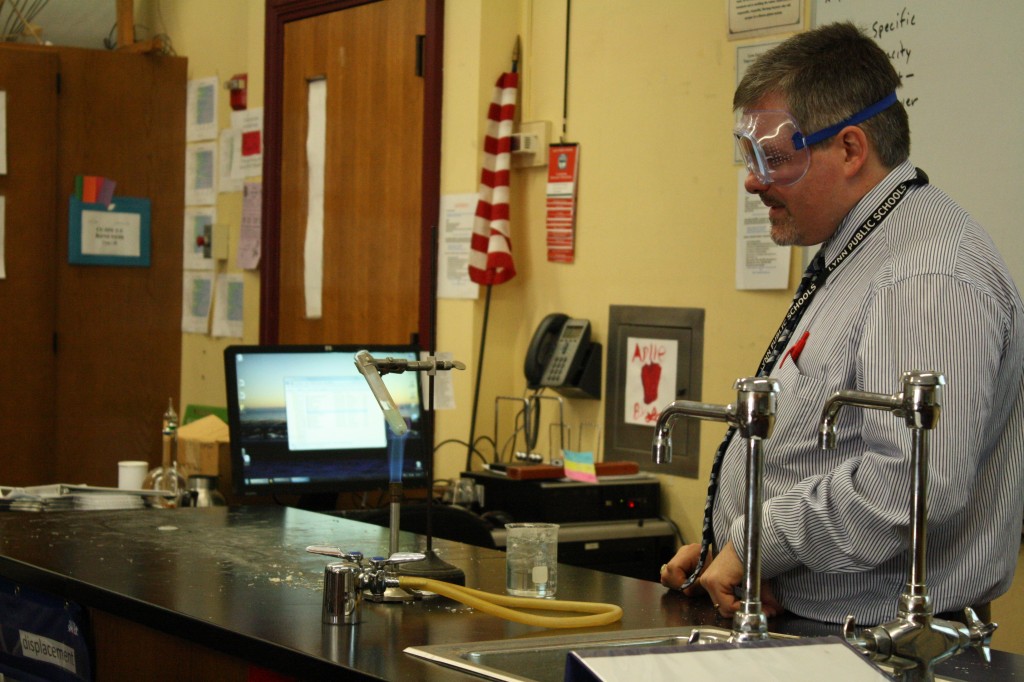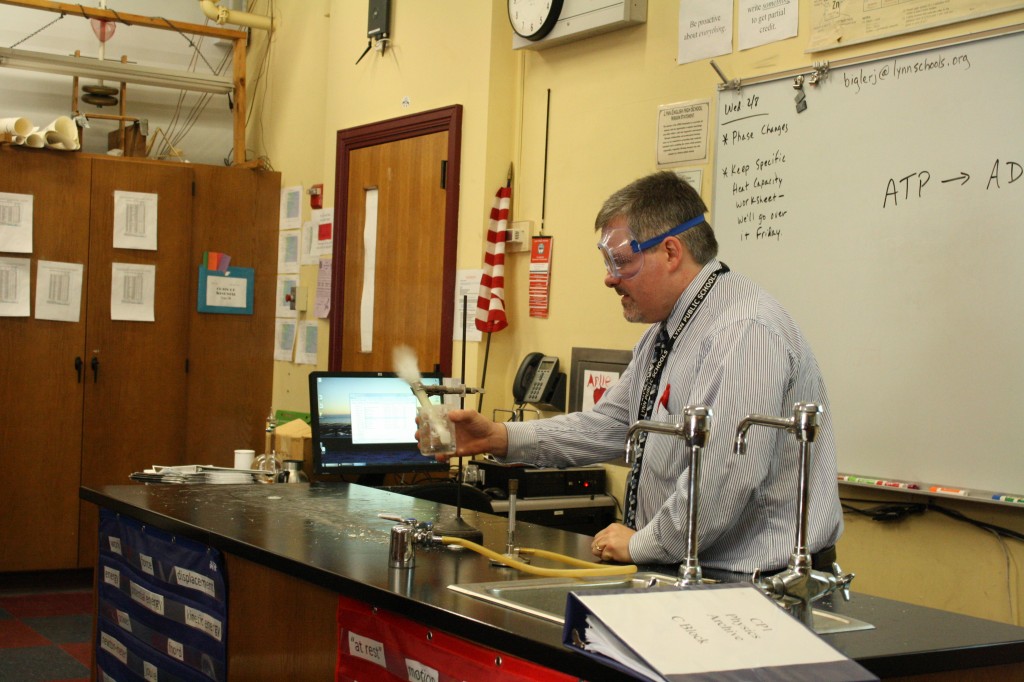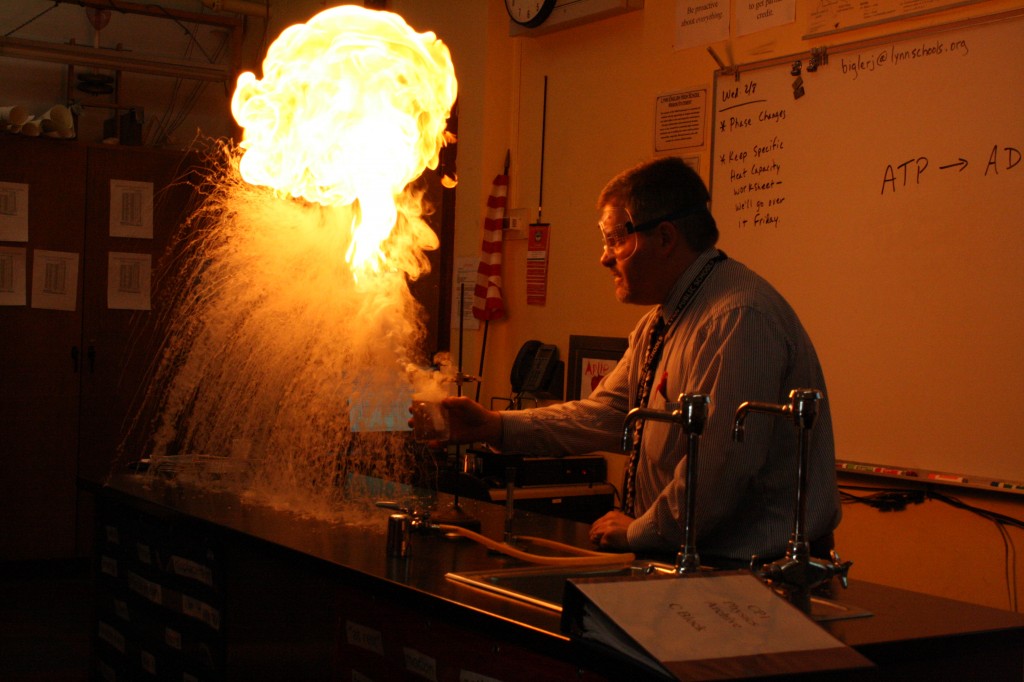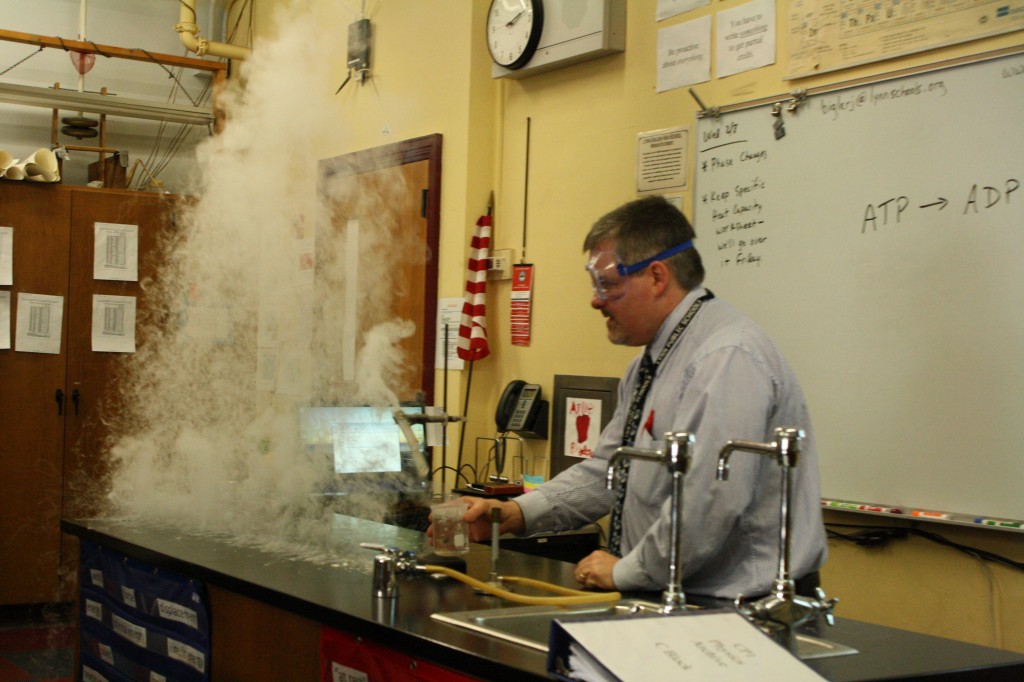Today I did one of my favorite demos for my classes. The demo is convincing visual evidence that forming intermolecular bonds releases energy.
When I explain to my students that breaking bonds requires energy, most of them believe it. Evidence might include the fact that you have to heat ice to melt it, and you have to heat water to boil it. However, many students have trouble grasping the concept that, because law of conservation of energy must hold, this means that when water freezes, the process must give off the same amount of heat as it took to melt the ice. My students accept this on the surface, but most of them have trouble really believing that ice gives off heat when it freezes.
The demo gives very convincing evidence that freezing a liquid gives off a substantial amount of energy. I learned about it at ChemEd 2009 from Liz Velikonja, a chemistry teacher from Brooklyn, NY. It starts with melting and beginning to boil paraffin (wax) in a test tube clamped to a ring stand. I used a Bunsen burner:
After this step, the test tube contains liquid paraffin, and there is a substantial amount of flammable paraffin vapor outside the mouth of the test tube.
At this point:
- I put a beaker of ice water over the end of the test tube, which causes the liquid paraffin in the test tube to solidify.
- Forming the intermolecular bonds of the solid releases a large amount of thermal energy.
- Because the heat is produced in the test tube, the only direction it can go is out the mouth of the test tube.
When the heat reaches the flammable paraffin vapor outside the mouth of the test tube, it ignites spectacularly:
Note the shower of condensed paraffin raining down from the fireball.
After the paraffin has burned, condensed paraffin vapor lingers in the air, and the lab bench is covered in a layer of wax:
(Thanks to Dina Robles, one of my current students and an LEHS yearbook photographer, for taking the pictures!)
Here is a link to a video taken of the demo in February 2013.





Oh, the people who clean the labs must LOVE you….
Um, the “people who clean the labs” would be me. After doing the demo in all of my classes, I spent about half an hour scraping the wax off the lab bench with a razor blade.
Looks like you are holding a little mushroom cloud, spectacular!
Hi, Jeff! It’s been a while (MIT, APO). Glad to see you’re shaping minds and making things go boom! I’m teaching math at Pepperdine University so I can’t make things go boom as often…
Oh, I forwarded this to the chemistry professors here at Pepperdine and one of them said this:
This is neat! It also looks like a horrific mess. It also looks like the potential for extraordinarily expensive doctor bills. Therefore, I think I might try it.
Thanks for this.
d
LOL!
The wax does make a mess, though it would be easy to put something like aluminum foil or a sheet of tile board down to catch it. I tried newspaper once, which was a bad idea because some of the bits of wax were still burning when they landed, and it caught the paper on fire.
As for the doctor bills, none yet, though I worry that I may have given one of my skittish colleagues PTSD by inviting her to watch it…
How much paraffin do you use? I can’t wait to try this…my students love fire! Thanks for sharing
Enough to fill a 15×125 mm test tube about halfway. I’d say around 2-4 grams.
Two pieces of advice.
1. It makes a huge mess on the lab table/floor/whatever. You want a clear, easily cleanable space of at least 2 meters from the test tube.
2. Don’t be tempted to put paper down to catch the wax. I tried this once. Some of the paraffin was still burning when it landed, and it set the paper on fire.
you are the COOLEST Chem teacher evah!
There’s something weird going on here at a deeper level than your explanation. It’s not true that the heat has nowhere to go but out the mouth of the test tube. Some is being lost through the side walls of the test tube — that’s why the wax is freezing in the first place. Typically freezing liquids release exactly enough heat to balance what’s being lost through cooling, so they stay at a constant temperature until the freezing is complete.
But in your demo, heat is being released in excess of what’s being lost through the sidewalls: that heat is causing wax to boil. Why does that heat released by freezing go into boiling hot liquid rather than keeping the cool liquid in contact with the solid above freezing? And if you take it as given that the heat goes into boiling, you need even *more* heat to raise that vapor above its autoignition temperature so it bursts into flame. Why does that heat go into heating vapor rather than boiling more liquid?
One thing’s for sure, though, this has something to do with paraffin in particular. For familiar substances, it takes much more energy to boil a gram of liquid than to freeze it (for water, it’s 7 times more). But for paraffin wax, it’s about equal: freezing wax releases an unusually large amount of energy. There may be some Gibbs free energy explanation here…. not sure.
Anyway, to wrap up, the demo nicely shows that energy is released by freezing, but I can’t explain why the energy chooses the specific form of superheated wax vapor rather than the usual much more boring forms.
This post led to an extensive discussion on the ChemEd-L discussion list.
The major fallacy in my explanation is that while the freezing does release heat, it does so at the melting point of the paraffin, which is below the autoignition temperature of the paraffin and thus is not useful in creating the fireball. The opinions of the contributors to the discussion were that what actually happens is probably something more like the following:
Heating paraffin to its boiling point causes some of it to decompose, producing free radicals. Plunging the test tube into ice water cracks the test tube, allowing a small amount of water to seep in. The molten paraffin is near its boiling point (around 370°C), which is hot enough to boil the water. Interestingly, the autoignition temperature of paraffin is 245°C. Presumably the paraffin does not ignite in the test tube because there is insufficient oxygen available.
When the water boils, the sudden expansion ejects steam and paraffin and free radicals into the air. Once the vapor contacts the room temperature air, it cools and begins to solidify. However, while this is happening, some of the free radicals come into contact with the paraffin vapor. These free radicals are highly reactive, and the reaction of the free radicals with the paraffin vapor is exothermic enough to ignite the vapor. This explains the approximately one-second delay between the appearance of the cloud of paraffin vapor and ignition.
Another photographer in the same class got the following picture of the demo from a different angle. This one clearly shows that the paraffin had started condensing before it ignited:
(The timing of this picture would be just before the one with the fireball in the sequence in the original post.)
Aha! You didn’t mention that the test tube cracks and allows water in! So I guess you get a steam explosion which atomizes the wax into droplets and throws it out into the air.
Once you have a finely divided mix of fuel and air at a temperature above the autoignition point, exciting chemistry is guaranteed, but it’s not really a consequence of latent heat release.
Shoot, I feel like I’ve kind of spoiled the demo. If you want a demo that definitely shows the heat released via phase transformation, you can melt and supercool hydrated sodium acetate, the material used in those hand warmer packs. But that’s much less explodey.
When I tried this before class, I didn’t quite get it to ignite, just smoked a lot, and the test tube broke in the ice water. Any suggestions?
I’m guessing that either you moved the test tube between heating and the ice (so the paraffin vapor was not right outside the end of the test tube) or that you need to heat the paraffin at a rolling boil for a little longer.
I had the test tube clamped to a ring stand. I heated it with a Bunsen burner. After a good 30 seconds of rolling boil, I turned off the gas, removed the Bunsen burner, picked up the beaker of ice water, and held it up so that the test tube was in the ice water.
In my experience, the test tube breaks every time. Some of the discussion on the ChemEd-L list suggests that the water entering the test tube full of boiling paraffin may play a key role in starting the reaction.
Some further data: I did the demo for each of my classes this year. In a couple of cases, the test tube cracked, but did not break, and the demo still created the fireball. After the demo, these cracked test tubes still held water without leaking, which suggests that they most likely did not allow water into the liquid paraffin.
I got a nice video this year, which I’ve added to this post.
I have come up with another potential explanation that doesn’t involve free radical chemistry. Paraffin contracts substantially when it freezes. My thought is that the following sequence of events may be responsible:
1. The paraffin in the test tube freezes and contracts.
2. Pockets of liquid paraffin that are trapped as the freezing paraffin contracts are excluded. The force from the contraction causes some of the liquid to be ejected from the end of the test tube, into the mass of paraffin vapor.
3. The fine drops of liquid paraffin (which has a high specific heat capacity) rapidly cool the vapor, causing it to condense.
4. The temperature of the paraffin is still well above its autoignition temperature. The sudden release of heat by the condensation provides enough thermal energy to overcome the activation energy for the oxidation of paraffin, and it ignites.
If this is indeed the mechanism, spraying a fine mist of water into the paraffin vapor instead of plunging the test tube into ice would likely achieve the same effect.
Clearly I need to try this. (Stay tuned…)
I have done this experiment many times with both my chemistry class and juniors for an exciting demonstration. It is easily one of my favourites.
I had two thoughts as to what is happening.
1st one:
By heating the paraffin wax, you are raising it to its flashpoint (autoignition) like you said above, by plunging the hot test tube in water and cracking it, when the water enters the cracks, it comes in contact with the VERY hot paraffin, causing it to rappidly expand as steam and force the paraffin out, not enought time to freeze the paraffin. when exposed to air it ignites.
2nd one:
By strongly heating the parrafin for an extended time, you are decomposing the long chain carbon molecules into shorter, highly reactive ones. when they are exposed to the oxygen in the air they react.
I have read both these explanations elswhere, but am yet to find a more common explanation.
Great blog By the way.
Regards
Andrew